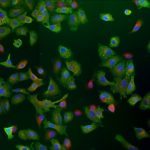Link to Pubmed [PMID] – 20627352
Virology 2010 Sep;404(2):215-24
Among a panel of 788 clinical influenza H3N2 isolates, two isolates were characterized by an oseltamivir-resistant phenotype linked to the absence of any detectable NA activity. Here, we established that the two H3NA- isolates lack any detectable full-length NA segment, and one of these could be rescued by reverse genetics in the absence of any NA segment sequence. We found that the absence of NA segment induced a moderate growth defect of the H3NA- viruses as on cultured cells. The glycoproteins density at the surface of H3NA- virions was unchanged as compared to H3N2 virions. The HA protein as well as residues 188 and 617 of the PB1 protein were shown to be strong determinants of the ability of H3NA- viruses to grow in the absence of the NA segment. The significance of these findings about naturally occurring seven-segment influenza A viruses is discussed.

